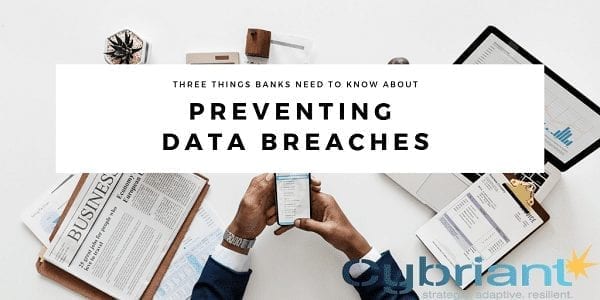Preventing data breaches could be one of the most important things your bank or financial services firm could focus on. Here are the reasons that data breaches should be a major focus.
Banks are increasingly targeted by hackers hoping to steal valuable data. Despite high threat levels and widespread knowledge of risks, many financial institutions find themselves underprepared. There are many reasons to focus on preventing data breaches, continue reading to find out a simple way Cybriant can help.
Financial services firms fall victim to cybersecurity attacks 300 times more frequently than businesses in other industries.
To make matters worse, the costs for financial institutions to repair these incidents are often far greater, which is problematic as the average data breach cost rose 5 percent to $7 million per breach in 2017. The average cost to U.S. businesses per record, lost or stolen, during a breach, was $225 – compare that to the financial industry’s number of $336 per record and you can see the issue.
Moreover, according to our research studies, consumers at this point expect their financial service providers to offer services that reduce the chance for exposure and, as importantly, quickly rectify the situation if their data does become compromised. Of the consumers we surveyed, 50 percent said they want their bank to offer these services and 43 percent felt the same about credit unions.
Since a data breach leads to a loss of customer faith and market reputation, it’s critical that financial institutions, including banks, protect their networks. Here are three things banks need to know about network security standards and preventing data breaches at financial institutions.
Related: The Financial Industry’s Biggest Threat
1. Many Banks Aren’t Budgeting Enough
IT staff needs to be able to respond to threats, and banks that tighten the budget on IT spending cripple this mission. Unfortunately, some banks reduce IT budgets to free up more money for customer-facing web tools and apps. This move short-circuits IT’s ability to defend against a cyber attack. Banks must take threats seriously, and this means adopting stricter network security standards and adequately funding IT departments for cyber monitoring and defense. If your clients find out that you are preventing data breaches to secure their investment, they may find a new bank.
Related: Top Cyber Security Websites
2. Two-factor authentication is No Longer Optional
Two-factor identification offers superior protection, but many employees dislike having to verify their identity using another method. Single-factor identification for apps and password-protected portals leaves banks vulnerable to an attack when cybercriminals have stolen legitimate user credentials.
Hackers are using more sophisticated and creative methods to easily steal login credentials. Once they have credentials, they can penetrate the system without raising any alarms.
Banks must ask themselves which is worse: the pain of having to log in via two-factor authentication or the pain of a serious data breach.
Two-factor authentication can thwart attacks. Given the low cost of implementation, it’s a no-brainer. You may even consider multi-factor authentication to ensure prevention data breaches.
3. Third-party Apps Present a Security Risk
Third-party apps promise a shortcut for financial institutions that don’t have the time or money to develop their app, but there is a safety risk here. In the race to keep up with the competition, some banks are adopting apps that may not be up to security standards. The short-term attempt to stand out can backfire big when apps are penetrated.
No matter the perceived need to offer customers apps and online tools, there is no excuse for failing to do due diligence when it comes to security standards or compliance requirements. Approving the app to appease the staff opens up the bank to a data breach through a third-party app. To address the security gap, banks should take a two-pronged approach: First, adopt stricter policies that target weak apps, and second, ensure all apps are monitored for cyber threats.
When hackers see that a bank is not an easy target, they will look for a financial institution that has unguarded access points. By addressing these security vulnerabilities, banks can reduce their risk and continue preventing data breaches.
Preventing Data Breaches Made Simple
You need to start with a cybersecurity strategy and framework. We recommend the NIST Cybersecurity Framework and have written several articles on how to use a framework in all your decision-making.
People, Process, and Technology is the cornerstone of ITIL, but can they also be used to ensure a proper cybersecurity foundation? The answer may surprise you! Read more, “People, Process, Technology in Cybersecurity or: How I Learned to Stop Worrying and Love the Process!”
Once you have the framework in place, focus on your compliance needs and risk reduction. We have created a tiered service that can not only make that efficient and affordable, but it can also actually make cybersecurity and preventing data breaches easy.



